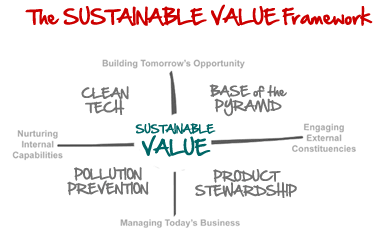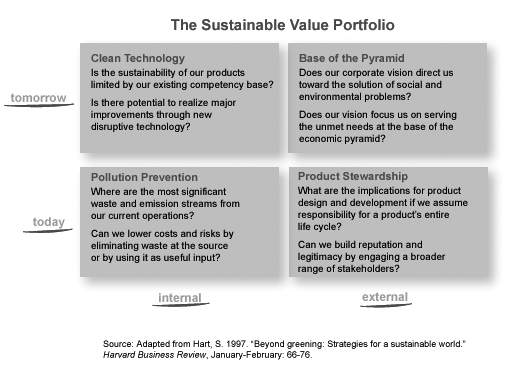For the past two decades, "sustainability" strategies have focused on eco-efficiency, stakeholder engagement, and social responsibility in existing core businesses. Now companies are being challenged to move "beyond greening" to develop breakthrough innovations that confront directly the two biggest problems facing humanity: growing inequity and accelerating environmental degradation.
The challenge--and the opportunity--is to harness technological and business model innovation to create new growth platforms that actually regenerate the environment and lift the base of the income pyramid--while growing and earning a profit.
One approach is to use the sustainable value framework highlighted in Beyond Greening: Strategies for a Sustainable World. While the article won the McKinsey Award for Best Article in the Harvard Business Review for 1997 and helped launch the movement for corporate sustainability, I fear that the message is still not getting through in the board room!
Here's why the sustainable value framework is still critical: it directly links the societal challenges of global sustainability to the creation of shareholder value by the firm.
There are four core dimensions of sustainability strategy with different linkages to firm performance and value creation:
Pollution Prevention: minimizing waste and emissions from current facilities and operations;
Product Stewardship: engaging stakeholders and managing the full life cycle of today's products;
Clean Technology: developing and deploying "next-generation" clean technologies; and
Base of the Pyramid: co-creating new businesses to serve the unmet needs of the poor and underserved.
Taken together as a portfolio, these strategies and practices hold the potential to:
Companies can begin by taking stock of each component through what I call their sustainable value portfolio. This simple diagnostic tool can help any company or business determine whether its strategy has the potential to truly create sustainable value.
Programs in pollution prevention and product stewardship are well institutionalized within most corporations today, and have saved hundreds of millions of dollars over the past decade. US-based companies have been especially focused on the efficiency gains and cost savings associated with pollution prevention. Highly publicized crises -- like those of Monsanto and Nike that failed to successfully engage the views of stakeholders -- have also caused growing numbers of firms to explore strategies for product stewardship.
European companies have been particularly active in engaging in stakeholder dialogue, extending producer responsibility for products, and adopting more inclusive forms of corporate governance.
Research and consulting experience, however, suggests that few firms seem to recognize -- let alone exploit -- the full range of sustainable business opportunities available. Most companies focus their time and attention primarily on the bottom half of the matrix (short-term solutions tied to existing products and stakeholder groups). Focusing on incremental improvements to existing products and businesses is an important step, but it neglects the vast opportunities associated with clean technology, and the largely underserved markets at the base of the economic pyramid.
Indeed, addressing the full range of sustainability challenges can help to create shareholder value, and may represent one of the most under-appreciated avenues for profitable growth in the future.
What is your company doing? Is there a plan? Ask yourself "why?" and "why not?"
The challenge--and the opportunity--is to harness technological and business model innovation to create new growth platforms that actually regenerate the environment and lift the base of the income pyramid--while growing and earning a profit.
One approach is to use the sustainable value framework highlighted in Beyond Greening: Strategies for a Sustainable World. While the article won the McKinsey Award for Best Article in the Harvard Business Review for 1997 and helped launch the movement for corporate sustainability, I fear that the message is still not getting through in the board room!
Here's why the sustainable value framework is still critical: it directly links the societal challenges of global sustainability to the creation of shareholder value by the firm.

There are four core dimensions of sustainability strategy with different linkages to firm performance and value creation:
Pollution Prevention: minimizing waste and emissions from current facilities and operations;
Product Stewardship: engaging stakeholders and managing the full life cycle of today's products;
Clean Technology: developing and deploying "next-generation" clean technologies; and
Base of the Pyramid: co-creating new businesses to serve the unmet needs of the poor and underserved.
Taken together as a portfolio, these strategies and practices hold the potential to:
- reduce cost and risk (pollution prevention);
- enhance reputation and legitimacy (product stewardship);
- accelerate innovation and repositioning (clean technology); and
- crystallize growth path and trajectory (base of the pyramid)
Companies can begin by taking stock of each component through what I call their sustainable value portfolio. This simple diagnostic tool can help any company or business determine whether its strategy has the potential to truly create sustainable value.

Programs in pollution prevention and product stewardship are well institutionalized within most corporations today, and have saved hundreds of millions of dollars over the past decade. US-based companies have been especially focused on the efficiency gains and cost savings associated with pollution prevention. Highly publicized crises -- like those of Monsanto and Nike that failed to successfully engage the views of stakeholders -- have also caused growing numbers of firms to explore strategies for product stewardship.
European companies have been particularly active in engaging in stakeholder dialogue, extending producer responsibility for products, and adopting more inclusive forms of corporate governance.
Research and consulting experience, however, suggests that few firms seem to recognize -- let alone exploit -- the full range of sustainable business opportunities available. Most companies focus their time and attention primarily on the bottom half of the matrix (short-term solutions tied to existing products and stakeholder groups). Focusing on incremental improvements to existing products and businesses is an important step, but it neglects the vast opportunities associated with clean technology, and the largely underserved markets at the base of the economic pyramid.
Indeed, addressing the full range of sustainability challenges can help to create shareholder value, and may represent one of the most under-appreciated avenues for profitable growth in the future.
What is your company doing? Is there a plan? Ask yourself "why?" and "why not?"